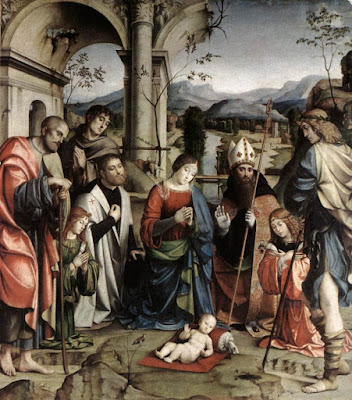Edward Hutton interrupted his tour of Umbria to spend the winter in Rome. But he did take time to visit Ulisse, his young traveling companion, in the boy's hometown of Dolcedorme where they attending the Christmas Midnight Mass. Hutton's charming account is a unique historical document.
Ah! That Midnight Mass! … I am not likely to forget it. I had gone with Ulisse, who guided me through the dark and narrow ways, up to the Collegiata, enthroned above the city, under those enormous and precipitous rocks, like giant’s teeth, which distinguish Dolcedorme.
It is a large church, rebuilt after an earthquake, in the seventeenth century; but large and spacious though it was, it was full. And not only of the faithful, not only of the women and the poveri. The whole city seemed to be there when the bell sounded for the third time.
In their own place sat the women, young and old, devout enough, and for the most part already on their knees. Behind and about, against the pillars and side-altars, stood the men, a vast crowd. And the noise! The whole church was filled with it, and the air was already stifling.
Over all the tumult came at last the organ. In the cora they began to sing Te Deum. It was the end of Matins. Mass was about to begin.
Still the people came in under the heavy leather curtains. The church was packed. More candles were lighted: more music poured from the organ. Finally, in procession, behind the great Byzantine cross, came Sua Ecclenzia—the whole concourse bent like a field of corn under a wind—blessing as he came. He was to sing Mass. Over the Crucifix on the high altar his single candle shone.
Ulisse and I stood before a pillar on the Epistle side, half-way down the great nave. Mass began. Domine dixit ad me … Kyrie eleison … Christie eleison … Kyrie eleison.
Monsignor intoned the Gloria in excelsis. The organ burst out into a great peal of music, the bells rang, everyone sang or whistled. …Most whistled.
Whistled!
Not with the lips only as one whistles an air, but with the fingers in the mouth to make a noise, as much noise as possible. Still others had brought whistles with them, and were using them with all their might.
I was astonished. I was scandalized. Surely my ears deceived me. It was so hot and the odour.…
But no, the whistling continued. There was Ulisse with both his fists at his mouth, whistling for all he was worth.
Ma come! Was this a theatre or a church? Was this some piece being hooted off the stage or the first Mass of Christmas? I turned to Ulisse.
“Ma si, signore, di qua e di la si fischia.”
“They’re whistling all over the place!” But why?
There was a little silence; the Gloria had finished itself.
Surely Monsignor would not continue? But no, the Mass proceeded as usual. The great Epistle proclaimed Him qui dedit semetipsium pro nobis, ut nos redimeret ab omni iniquitate….
The Gospel, known from childhood, unfolded itself from the edict of Caesar Augustus to the peace born on earth to men of good will.
Slowly we came to the Christmas Preface, the Christmas Sanctus, sung here to a strange dancing measure as in the picture of Botticelli. I had forgotten the unseemly interruption at the Gloria. I had forgotten everything.…
There it was again! Suddenly, at the Elevation! But worse than before, more exulting, more joyous, more insolently enthusiastic and rejoicing. It was beyond all possible bounds. In England….
“But what is it then?” I leant to Ulisse.
“Ma signore, it is the shepherds! E un pio ricordo dei suoni pastorali quando necque nostro Signore.” “A pious remembrance of the shepherds’ music when Our Lord was born.” But I… I, too, would whistle. I … I, too, whistled—only the sounds would not come. What could be the matter with my throat?
“Peccato!” whispered Ulisse, that one cannot hear also the voice of the ox and the ass.
###
Edward Hutton: Assisi and Umbria Revisited, London, 1953. Pp. 124-125.
Note: This post originally appeared on this site on 6/20/23.































